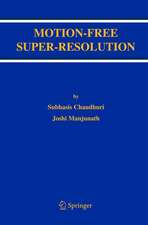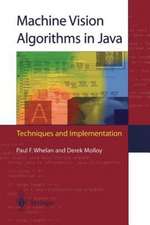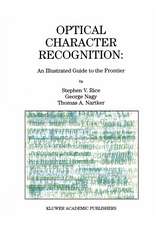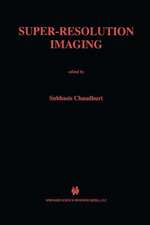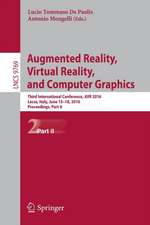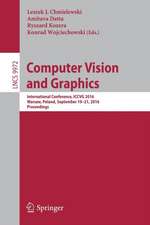Depth From Defocus: A Real Aperture Imaging Approach
Autor Subhasis Chaudhuri Cuvânt înainte de A. Pentland Autor A.N. Rajagopalanen Limba Engleză Hardback – 26 mar 1999
| Toate formatele și edițiile | Preț | Express |
|---|---|---|
| Paperback (1) | 629.73 lei 6-8 săpt. | |
| Springer – 24 oct 2012 | 629.73 lei 6-8 săpt. | |
| Hardback (1) | 634.44 lei 6-8 săpt. | |
| Springer – 26 mar 1999 | 634.44 lei 6-8 săpt. |
Preț: 634.44 lei
Preț vechi: 793.05 lei
-20% Nou
Puncte Express: 952
Preț estimativ în valută:
121.42€ • 126.49$ • 100.95£
121.42€ • 126.49$ • 100.95£
Carte tipărită la comandă
Livrare economică 08-22 februarie 25
Preluare comenzi: 021 569.72.76
Specificații
ISBN-13: 9780387986357
ISBN-10: 0387986359
Pagini: 172
Ilustrații: XIX, 172 p.
Dimensiuni: 155 x 235 x 14 mm
Greutate: 0.41 kg
Ediția:1999
Editura: Springer
Colecția Springer
Locul publicării:New York, NY, United States
ISBN-10: 0387986359
Pagini: 172
Ilustrații: XIX, 172 p.
Dimensiuni: 155 x 235 x 14 mm
Greutate: 0.41 kg
Ediția:1999
Editura: Springer
Colecția Springer
Locul publicării:New York, NY, United States
Public țintă
ResearchCuprins
1 Passive Methods for Depth Recovery.- 1.1 Introduction.- 1.2 Different Methods of Depth Recovery.- 1.3 Difficulties in Passive Ranging.- 1.4 Organization of the Book.- 2 Depth Recovery from Defocused Images.- 2.1 Introduction.- 2.2 Theory of Depth from Defocus.- 2.3 Related Work.- 2.4 Summary of the Book.- 3 Mathematical Background.- 3.1 Introduction.- 3.2 Time-Frequency Representation.- 3.3 Calculus of Variations.- 3.4 Markov Random Fields and Gibbs Distributions.- 4 Depth Recovery with a Block Shift-Variant Blur Model.- 4.1 Introduction.- 4.2 The Block Shift-Variant Blur Model.- 4.3 Experimental Results.- 4.4 Discussion.- 5 Space-Variant Filtering Models for Recovering Depth.- 5.1 Introduction.- 5.2 Space-Variant Filtering.- 5.3 Depth Recovery Using the Complex Spectrogram.- 5.4 The Pseudo-Wigner Distribution for Recovery of Depth.- 5.5 Imposing Smoothness Constraint.- 5.6 Experimental Results.- 5.7 Discussion.- 6 ML Estimation of Depth and Optimal Camera Settings.- 6.1 Introduction.- 6.2 Image and Observation Models.- 6.3 ML-Based Recovery of Depth.- 6.4 Computation of the Likelihood Function.- 6.5 Optimality of Camera Settings.- 6.6 Experimental Results.- 6.7 Discussion.- 7 Recursive Computation of Depth from Multiple Images.- 7.1 Introduction.- 7.2 Blur Identification from Multiple Images.- 7.3 Minimization by Steepest Descent.- 7.4 Recursive Algorithm for Computing the Likelihood Function.- 7.5 Experimental Results.- 7.6 Discussion.- 8 MRF Model-Based Identification of Shift-Variant PSF.- 8.1 Introduction.- 8.2 A MAP-MRF Approach.- 8.3 The Posterior Distribution and Its Neighborhood.- 8.4 MAP Estimation by Simulated Annealing.- 8.5 Experimental Results.- 8.6 Discussion.- 9 Simultaneous Depth Recovery and Image Restoration.- 9.1 Introduction.- 9.2 Depth Recovery and Restoration using MRF Models.- 9.3 Locality of the Posterior Distribution.- 9.4 Parameter Estimation.- 9.5 Experimental Results.- 9.6 Discussion.- 10 Conclusions.- A Partial Derivatives of Various Quantities in CRB.- References.

